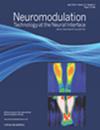运动反应很重要:骶神经调控术中的导线放置与泌尿系统疗效的关系
IF 3.2
3区 医学
Q2 CLINICAL NEUROLOGY
引用次数: 0
摘要
目的:本研究旨在描述骶神经调控(SNM)导联置入过程中引发的盆底肌肉(PFM)运动反应:本研究旨在描述骶神经调控(SNM)导联置入过程中引发的盆底肌肉(PFM)运动反应,确定其在改善治疗效果方面的作用:我们开展了一项前瞻性试验研究(2018 年 1 月至 2021 年 9 月),研究对象包括膀胱过度活动症或非梗阻性尿潴留患者--这是一个非常单一的群体,没有任何影响膀胱功能的病史--他们都接受了骶神经调控治疗。外部脉冲发生器连接三周。成功的定义是改善≥50%。使用多阵列探头记录 PFM 肌电图。使用线性混合模型分析法(LMM)对不同电刺激水平(最高 10V,临床相关强度最高 3V)和盆底不同部位(四侧、三深)的盆底肌电运动反应(峰-峰振幅、曲线下面积 [AUC] 或潜伏期)的差异进行建模:研究对象包括 26 名女性(总体成功率为 81%)。随着排尿日记数据的改善,10V 以下刺激强度(LMM:P 值分别为 0.0046 和 0.0043)和 3V 以下刺激强度(LMM:P 值分别为 0.0261 和 0.0416)的峰-峰振幅和 AUC 均有所提高。对 PFM 不同部位的子分析表明,所有不同侧面(首次校正 p 值 < 0.0125)和深度(首次校正 p 值 < 0.0167)在 10V 和 3V 分析中均存在统计学意义上的显著差异,即改善百分比越高的部位越有利,只有两个部位例外:后层在临床相关刺激强度下的峰-峰振幅(LMM:p 值:0.0752)和后层在 10V 刺激强度下的 AUC(LMM:p 值:0.0557)。根据二分法结果(有反应者与无反应者),总体平均峰-峰振幅和 AUC 没有统计学意义上的差异:结论:在导联置入过程中获得的术中 PFM 肌电图有助于更准确地将导联定位到神经。据我们所知,这是第一项将基于电诊断测试的带线导联置入与颅内压增高症预后相关联的研究。事实证明,它是一种可靠的测量工具,可作为测试阶段治疗反应的生理生物标志物。强烈的运动反应可以让外科医生确信,导联的正确位置已经确定,从而获得最大疗效。本文章由计算机程序翻译,如有差异,请以英文原文为准。
Motor Response Matters: Lead Placement and Urologic Efficacy Linked in Sacral Neuromodulation
Objectives
This study aimed to characterize the pelvic floor muscles (PFM) motor response provoked during sacral neuromodulation (SNM) lead placement, determining its utility in improving therapy delivery.
Materials and Methods
A prospective pilot study (January 2018–September 2021) was performed including patients with overactive bladder or nonobstructive urinary retention—a very homogeneous group without any medical history interfering with bladder function—who underwent SNM. An external pulse generator was connected for three weeks. Success was defined as ≥50% improvement.
PFM electromyography was recorded using a multiple array probe.
Differences in electrical PFM motor response (peak-to-peak amplitude, area under the curve [AUC] or latency) among different electrical stimulation levels up to 10V (and the clinically relevant intensities up to 3V) and different parts (four sides, three depths) of the pelvic floor were modeled using linear mixed model analysis (LMM).
Results
The study population comprised 26 women (overall success 81%). With increasing improvement in voiding diary data, higher peak-to-peak amplitudes and AUC were seen for up to 10V stimulation intensities (LMM: p value 0.0046 and 0.0043, respectively) and up to 3V stimulation intensities (LMM: p value 0.0261 and 0.0416, respectively). Subanalysis of the different parts of the PFM showed all different sides (first corrected p value < 0.0125) and depths (first corrected p value < 0.0167) presented with statistically significant differences in favor of those with higher percentage improvement for the 10V and 3V analyses, with only two exceptions: peak-to-peak amplitude at the posterior layer at the clinically relevant stimulation intensities (LMM: p value: 0.0752) and AUC at the posterior layer for the stimulation intensities on 10V (LMM: p value: 0.0557). No statistically significant differences were found for the overall mean peak-to-peak amplitude and AUC based on dichotomous outcome (responders vs nonresponders).
Conclusions
Intraoperative PFM electromyography obtained during lead placement aids in more accurate targeting of the lead to the nerve. To our knowledge, this is the first study to correlate tined lead placement based on electrodiagnostic testing and outcome in SNM. It has been proved to be a reliable measurement tool, serving as a physiological biomarker of treatment response during the test phase. A strong motor response can make the surgeon confident that the correct position of the lead has been established for maximal benefit.
求助全文
通过发布文献求助,成功后即可免费获取论文全文。
去求助
来源期刊

Neuromodulation
医学-临床神经学
CiteScore
6.40
自引率
3.60%
发文量
978
审稿时长
54 days
期刊介绍:
Neuromodulation: Technology at the Neural Interface is the preeminent journal in the area of neuromodulation, providing our readership with the state of the art clinical, translational, and basic science research in the field. For clinicians, engineers, scientists and members of the biotechnology industry alike, Neuromodulation provides timely and rigorously peer-reviewed articles on the technology, science, and clinical application of devices that interface with the nervous system to treat disease and improve function.
 求助内容:
求助内容: 应助结果提醒方式:
应助结果提醒方式:


